Enterprise resource planning (ERP) systems have become the backbone of industry, offering crucial efficiency optimisation, regulatory compliance, real-time optics and more. With experience of various ERP solutions spanning five decades, Advania’s ERP Sales consultant Ashley Jones takes you on a whistlestop tour of the history of ERP systems, from the earliest offerings to modern ERP solutions. You’ll also get a look at how recent developments in artificial intelligence (AI) are moving the goalposts of long-standing business norms.
The 1980s: the history of ERP begins
Ah, the 1980s – a time of big hair, neon colours, and the dawn of ERP software. I remember it well. As the 1980s go, my personal claim to fame was passing-up tickets to what I dismissed as ‘just another benefit concert.’ Live Aid, it turned out, would be a little bit more than that. What did I know?
Back then, businesses were starting to realise that managing their operations with pen and paper just wasn’t cutting it anymore. Technology was advancing and the eye-wateringly expensive Mainframe, Mini and Microcomputers of big business looked set to become things of the past.
My involvement in the IT sector began in those days as an office junior whose experience in computers from technical college made me the ideal (or perhaps the only) candidate in the office to assist the Finance Manager in transferring all the accounts from a manual NCR card system to an early version of Pegasus accounts running on a state-of-the-art Apricot F10 PC – it had an internally-fitted 10MB Winchester!
The F10 came with a GEM graphical interface and a trackball mouse, which I was reliably informed by the engineer who set it up was just a gimmick and would never catch on. He’d have probably passed on the Live Aid tickets as well.
The decade was bubbling with fresh-faced entrepreneurs, with the likes of Bill Gates, Steve Jobs and the UK’s Sir Clive Sinclair all vying to make their computers and software the leaders in the market. The choices seemed endless – some good, some not so good; over time, the business equivalent of natural selection served to thin the herd.
Enter material requirements planning (MRP) systems. These early systems were primarily focused on manufacturing processes, helping companies manage their production schedules and inventory.
However, these solutions seemed to be marketed at larger companies with deeper pockets, leaving small and medium-sized businesses (SMBs) wanting something that their more meagre budgets could afford. They also needed to be more user-friendly: a dear old mentor of mine always used to refer to them as being as friendly as a cornered rat.
But as businesses grew, so did their needs. They wanted more than just manufacturing management – they needed a way to integrate all their business processes. This led to the birth of ERP systems, which aimed to bring together various functions such as finance, HR, and supply chain into a single, cohesive system. The history of ERP was about to enter a new age.
The 1990s: ERP goes mainstream
Fast forward to the 1990s, and ERP systems were starting to gain serious traction. Companies like SAP and Oracle were leading the charge, offering robust ERP solutions that promised to streamline business operations. These systems were no longer just for manufacturing – they were now being used across various industries.
The ’90s also saw the rise of client-server architecture, which battled with multi-user operating systems like Unix and Xenix for popularity, if not outright supremacy. However, the client-server approach made ERP systems more accessible and user-friendly, since businesses could now run their ERP software on their own servers, giving them more control and flexibility. Novell Networks seemed to be the accepted standard in the public and private sector, and its reign seemed set for years to come.
It was at this point that early MRP solutions started to prove their worth. I recall the impact that a ‘production control’ feature had on a small engineering business in the back streets of Sheffield, where the two owners were shocked to find that their standard manufacturing costs had been significantly under-calculated – and for a very long time.
This had been proven to them in the first few days of using a barcode-enabled Shop Floor Data Collection system, which was now giving them accurate and live work-in-progress figures, so much so that they made a horrible discovery. It turned out that they’d been jumping to meet the demands of their ‘best customer’ over everyone else, but the two owners had now discovered that the core product they manufactured for them had actually been a loss maker for the last few years.
A bigger shock came when the two owners summoned up the courage to call a meeting with the customer to break the unfortunate but unavoidable news that they could no longer supply them their product for the same price. “Yes,” replied the client, “we’ve never understood how you were making them so cheaply and we’ve been wondering when you would call a meeting like this!”
Needless to say, a new pricing was negotiated, the relationship continued and the small Sheffield engineering company went back into ‘the black’ for the first time in ages.
However, for many, the 1990s is remembered for a panic-filled ending to the decade, resulting from a decision to use two-digit year fields in data records, which set a ticking timebomb that would have devastating effects around the world when the clocks went full circle at midnight on 31st December 1999.
Thankfully the necessary drastic action was taken and the New Year of 1st January 2000 was marked with the joyful popping of champagne corks and no undue business concerns. A major milestone in the history of humanity – and the history of ERP platforms – passed smoothly and with great sighs of relief.
The internet boom and the dawn of modern ERP systems
The turn of the millennium brought with it the internet boom, along with lavish promises of entirely different ways of living and how to do business. Things got a little over-excited with the ‘dot com boom’ and good money was paid for ‘dot com’ businesses even if there wasn’t any substance to them.
Nevertheless, –just like nature, software abhors a vacuum and ERP systems were quick to adapt. Microsoft itself entered the modern ERP arena having acquired Great Plains, which became Dynamics GP, followed by Navision, which in turn became DynamicsNAV
Web-based modern ERP solutions started to emerge, allowing businesses to access their systems from anywhere with an internet connection. This was a game-changer as it meant that companies could now operate more efficiently and respond to changes in real-time.
One notable success story that springs to mind around 2006 was an ERP project with an engineering supplies company. The company that found itself with four branches through the acquisition of competitors’ businesses, but each branch ran a completely different software solution in each instance, with none of them talking to the others.
The operating problems were significant as a result. A simple example of the problems they faced could be placing a customer on stop at one branch, but who could effectively still trade with any of the other branches. Absolute pandemonium could ensue, but this is what dictated the need for change and where a centralised solution running over low-cost internet virtual private network (VPN) connections solved this problem (and others) overnight. Indeed, the client now had a live company-wide picture of what was happening in real-time, meaning that problems could now be visualised, and steps taken to remedy them.
A consolidated analysis of the company’s stock holding across all four branches showed that they had somewhere in the region of £1 million-worth of redundant stock. An inconvenient discovery certainly, but by disposing of the redundant stock by using the new ERP system to identify likely customer candidates who had purchased these items in the past, the business converted money that was tied up in dead stock into money in their bank account in the short space of a few weeks.
The 2000s also saw the possibility of software as a service (SaaS) ERP solutions emerge. Instead of buying and maintaining their own ERP software, businesses could now subscribe to a cloud-based service. This made ERP systems more affordable and accessible, especially for SMBs.
The 2010s: mobility and integration
As we moved into the 2010s, the focus shifted towards mobility and integration.
Smartphone technology now came in to its own, offering greater computing in the palm of your hand than NASA had provided the Apollo astronauts in their Saturn V rockets and command modules during the moon missions of the late 1960s and 1970s.
This relatively low-cost and readily available platform presented an obvious opportunity to businesses that wanted ERP systems that could be accessed on the go, leading to the development of mobile ERP apps. These apps allowed employees to manage their tasks from these same smartphones and tablets, making it easier to stay continuously productive around the business and while on the move.
Integration also became a key theme during this decade. Businesses wanted their ERP systems to seamlessly integrate with other software solutions, such as customer relationship management (CRM) and business intelligence (BI) tools. This led to the development of more flexible and customisable ERP systems that could be tailored to meet the unique needs of each business.
The 2020s: AI and beyond with modern ERP
Today, nearing the mid-point of the 2020s, modern ERP systems are smarter and more powerful than ever. This is evident in the range of ERP, MRP, Field Service and associated solutions available from Microsoft’s Dynamics 365 portfolio of business apps.
Indeed, Microsoft had already designed Dynamics 365 to leverage the functionality the Microsoft 365 stack of office applications, but it hasn’t stopped there. Microsoft has been keen to ensure from the outset that its Copilot AI tools are also integrated into its Dynamics 365 solutions, providing businesses with advanced analytics and predictive capabilities from a single-source business-wide solution.
This is a game-changer and sets the standard in the industry, as it allows companies of any size to instantly make more informed decisions to stay ahead of the competition.
The rise of Internet of Things (IoT) is also transforming modern ERP systems. Previously confined only to the realms of science fiction, businesses can now connect their ERP software to various devices and sensors, providing real-time data and insights across their local and worldwide infrastructure.
This is particularly useful for industries like manufacturing and logistics, where real-time monitoring and optimisation are crucial, and where – with global workforces and multiple time zones – the world really is becoming a village that requires constant and instant communication.
Looking ahead: the future of modern ERP software
It should be obvious to everyone that ERP systems will continue to evolve and adapt to the changing needs of businesses and industry demands. With advancements in technology, and the continued investment that Microsoft makes in its business solutions year in, year out, we can expect to see even more innovative features and capabilities that will help companies operate more efficiently and effectively.
And there you have it – a whirlwind history of ERP software from the 1980s to today. It’s been quite a journey, and it’s exciting to think about what possibilities exist for our organisation in an AI-powered modern ERP world. If you have any questions or want to dive deeper into a specific solution or need, our experts are ready to speak to you today.








